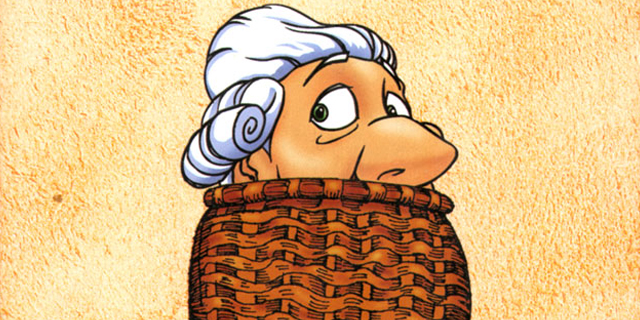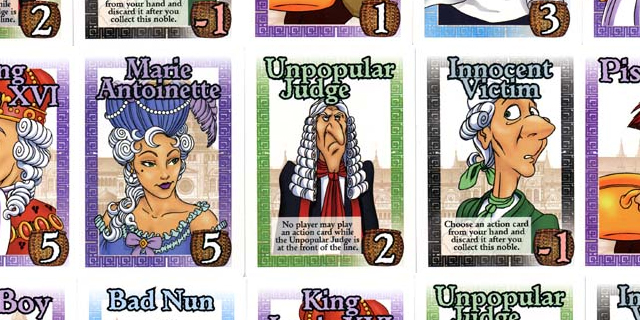
Guillotine is a fast-moving filler designed by Paul Peterson back in 1998, when it won the Origins Award for Best Traditional Card Game. I had wanted to pick it up for a while, but never really got around to it. Honestly, I kind of forgot about it until last month, when the untimely death of Quinton Hoover (one of the game’s artists and my all-time favorite Magic: the Gathering artist) returned it to the forefront of my mind. Since Mr. Hoover hadn’t illustrated a Magic card in over four years, owning Guillotine gave me an opportunity to see some of his work more frequently than regular Magic play would allow.
Guillotine is comprised of two decks: a Nobles deck and an Action deck. Up to five players each receive a hand of five action cards, and twelve nobles are lined up to begin the first day (round) of play. In turn, each player has the option of playing an action card. These cards usually move one or more of the nobles forward or backward, but there are some special actions and surprises as well. Whether a card was played or not, the player then collects the noble at the front of the line and places it face-up in front of them. Finally, they draw a new action card and play passes to the left.
When the last noble is collected from the line, the day ends. A new line-up of twelve nobles is then dealt out to begin the second day. A third and final day follows, at which point players add up the values of their collected nobles and other miscellaneous scoring to determine the winner.

That’s all there is to it. The assembly-line nature of play, with a noble being collected at the end of every turn regardless of actual actions taken (unless that action prevents collection), keeps the game moving quickly. There isn’t much in the way of strategy here, as you generally want to be collecting the highest-valued noble possible, but some card combinations might suggest a different course of action. Keeping an eye on your opponents’ scores is also useful, as some Action cards can affect other players’ collections. One category of “nobles” is actually worth negative points if collected since they represent peasants. Manipulating the line to avoid and/or force the collection of these non-nobles can be just as important as trying to collect the high-scoring ones.
As a filler-level game, Guillotine provides the right mix of humor, simplicity and fast play. The recommended age of players is twelve and up, although I suspect that this is mostly due to the somewhat macabre theme more than anything else. If that sounds like something that tickles your interests, you should be able to pick up Guillotine for about $20.



















